The conventional wisdom is that Nintendo has screwed up. They have lost the plot. Dropped the ball. Somehow sunk their own battleship. But they’re actually doing a bunch of things right too.
Let’s not focus on the very real storm clouds, for once, and focus on four bright spots that might change how you think about the Nintendo of 2014. None of what follows will explain away the company’s faults. None of it suggests Nintendo can easily overcome their current troubles. But it might help flesh out the portrait that everyone has of the gaming company by highlighting some things that don’t make headlines for Nintendo.
They’re Making Some New Characters.
You may have missed this, but it’s been happening — even as people have been saying that it hasn’t. It’s not been happening the way it did in the ’80s or ’90s, mind you.
Some context: For the longest time fans and media folks have complained that Nintendo stopped making new things. They have argued that the maker of Mario, Zelda and Donkey Kong has turned into the re-maker of Mario, Zelda and Donkey Kong, relying on the past and banking on rehashes. Critics have measured Nintendo’s supposed lack of innovation with the numbers of characters the company has made. They have found them lacking.
Nintendo just doesn’t make new characters anymore, right? This had been sort of true.
For at least half a decade, the 2001-era Pikmin seemed to hold the title of Nintendo’s Newest Game-Headlining Characters. Nintendo’s best counterpoint might have been that 2006’s Mii player avatars for the Wii were in fact new Nintendo characters (congratulations, Wii user… you’re the new Mario, as it were). Or maybe the the generic dogs from Nintendogs the year before should have counted? It’s hard to tell if Nintendo cared much about whether they were adding characters. The Wii and DS were succeeding even in the absence of new mascots to populate a Mario Kart or Smash Bros.
Speaking of the Smash Bros. roster… here’s the roster for the newest one, with the decade of creation for each character.
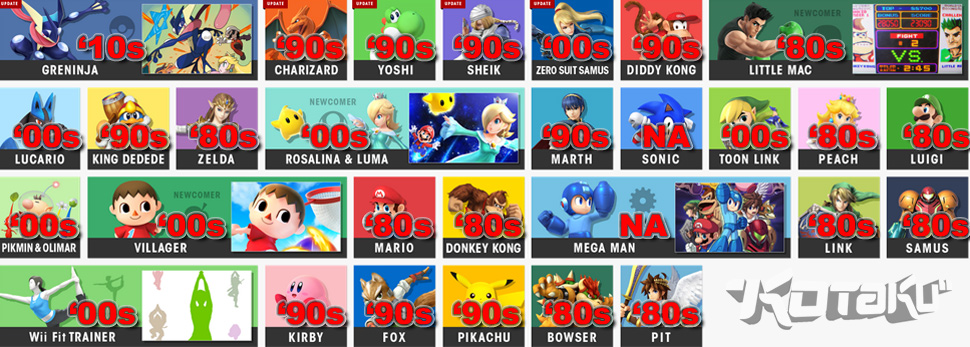
Not many recently-created ones, huh?
Critics associate a lack of new characters with a lack of innovation. Nintendo’s most successful character creator, Shigeru Miyamoto, persuasively protested against that point in an interview with me last year.
“Certainly from outside the company and even internally we have a lot of staff members who are talking about, we should create new [intellectual property, as in characters or series]. To me the question really comes down to: What is new IP and, by definition, what is a new game? And I think there’s a lack of understanding about the difference between the two.
“And so, from my perspective, a lot of people say, ‘Oh, you should make new characters and those would be fun games,’ but creating a new character doesn’t necessarily mean the game is going to be fun. You really need to be focusing on creating a new gameplay experience that’s fun and unique.”
Miyamoto might have had a point, but it would still be nice to see Nintendo creating good characters. It turns out that, in conjunction with partner studios, they have. They haven’t necessarily made characters that are destined to headline sequels for decades to come, but while so many gaming observers have only noticed Nintendo putting out the umpteenth game starring Mario or Link, Nintendo has indeed increased its character roster.
Sadly, there’s a good chance you’ve never heard of these guys:
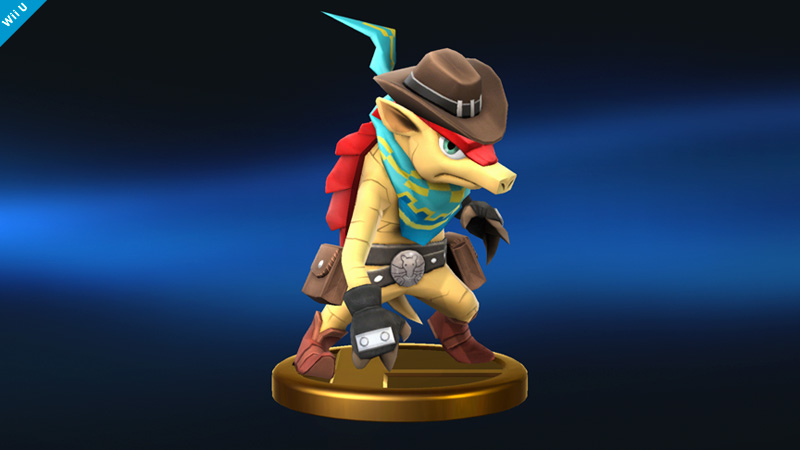
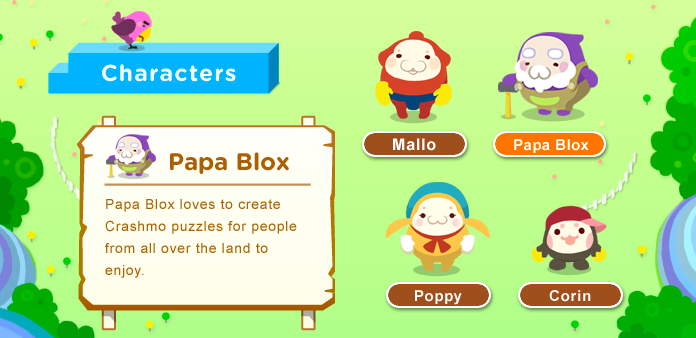
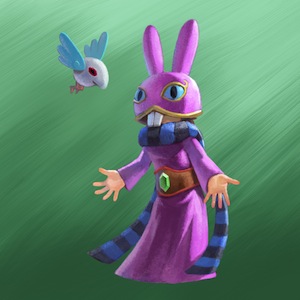
-
Dillon – Ring any bells? He’s a cowboy armadillo, star of two Dillon’s Rolling Western games. He hangs out with a squirrel who flies a gyrocopter, a shotgun-toting bear and a sniper squid.
Dillon is one of Nintendo’s edgier characters (relatively speaking), more Fox McCloud than Kirby. He’s the kind of well-designed, visually-distinct, colourful character you’d have expected Nintendo to be making for years. Well, he exists! He’ll be an assist trophy in the next Smash Bros., and he and his pals are featured in the best unlockable animation sequence in the Nintendo 3DS’ built-in puzzle game.
See? Good character design:
-
Papa Blox – Not a lead character, mind you. This old guy continues Nintendo’s tradition of making strangely compelling elderly characters (see: Cranky Kong, Peppy). This codger gives advice in the Pushmo and Crashmo games, which have their own distinct aesthetic. Like Dillon, he’s not just a new character, but a new character set in a new world with an entirely new cast around him.
There’s a whole roly-poly Pushmo/Crashmo aesthetic that could make for a fine Smash Bros. stage. Even the strangely-dour “carrier birds” have some charm. Papa Blox, I submit, would make a fine Mario Kart racer.
Ravio – This goofy-looking character from the recent Legend of Zelda: A Link Between Worlds initially appeared to simply be an item salesman, an incidental one-off addition to the ever-expanding Zelda cast.
Some late-game revelations position him as one of the more interesting characters to pop into a Nintendo game in a while. If you don’t know but would like to understand what makes Ravio special, this bio spells it out. Ravio could star in a very interesting Zelda spin-off if Nintendo desired to tell more of his story.
There are more. Some good. Some bad (see: Monita). Others are wonderful, albeit bizarre. There’s Rusty, the depressed, retired baseball-playing dog whose wife has left him and who spends the entirety of the delightfully odd Rusty’s Real Deal Baseball trying to bring his family back together. There’s the ever-expanding Fire Emblem cast, with the most recent game, Awakening, introducing some memorable fighters including, ironically, Kellam, the bruiser everyone forgets.
None of the above necessarily scream long-term, big-game headliner and most are probably in the league of a Fawful or a Professor E. Gadd, a well-designed bit player unlikely to ever make the Smash Bros. roster.
These characters nevertheless feel fresh. They populate new worlds rather than the same old Mushroom Kingdoms and Hyrules. Most importantly, they signal something else that Nintendo has been doing that’s even more important than making new characters. It’s the thing Miyamoto was talking about…making new experiences…
They’re Making Fun, Original Games.
It’s Nintendo’s own fault that anyone might dismiss them now as a once-innovative sequel factor. The company’s waterfall of sequels get most of the headlines and most of the promotion from Nintendo themselves.
When the company struggles, they hope that the newest Mario sidescroller or Smash Bros. or Zelda will lift their fortunes. They haven’t banked on a brand-new game since… was it the disappointing Wii Music in late 2008? Or, arguably, do you count 2013’s Wii U launch game Nintendo Land, even thought it was a collection of extensive mini-games set in a theme park dedicated to classic Nintendo franchises?
While Ubisoft’s been hatching Assassin’s Creeds and Watch Dogs and while Sony’s been uncorking Last of Uses and Uncharteds, Nintendo has failed to invent a brand-new big thing in quite some time. Nintendo is, however, making brand-new little things all the time. Good news there: their new little games have been good.
Nintendo’s new (small) games mostly appear on the 3DS. They tend to have the level of polish that people enjoy from a good Mario or Zelda as well as the tight gameplay and generous amount of content typical to the average Nintendo-published game.
Some of the better ones include:
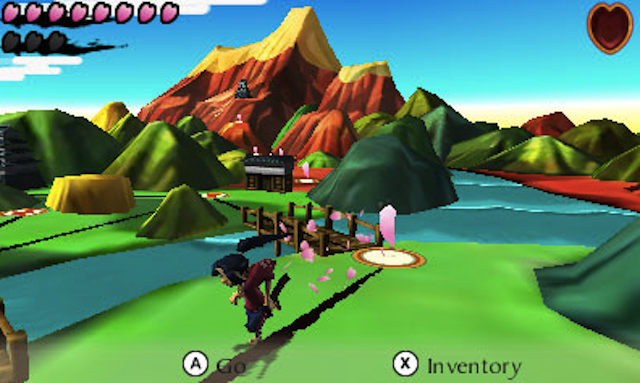
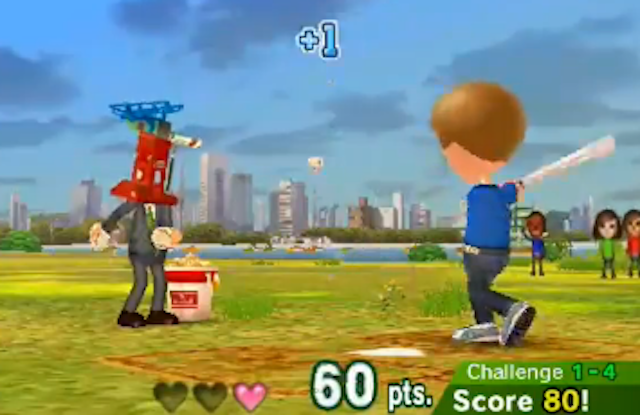
-
Sakura Samurai: Art of the Sword This is an original third-person samurai action game that involves moving around through old Japan, fighting arenas full of enemies with a counter-attack-centric combat system.
There are sword upgrades, items, towns, special abilities and so on. It’s essentially an action-RPG with a new cast of characters and enemies, using a setting Nintendo hasn’t tapped before.
-
Dillon’s Rolling Western – There have been two of these games. They are both pretty deep westerns that play as a mix of real-time strategy and third-person combat.
As Dillon, you try to stop rampaging enemies from wrecking your base over the course of a series of days, with gameplay changing throughout the day/night cycle. You meet and recruit characters at various outposts, explore what looks more or less like Utah desert beyond, fortify each area before an attack and then use your allies, your fortifications and direct combat to stop waves of invading enemies. The games have a colourful cast and use a setting that is unusual for Nintendo.
- Pushmo/Crashmo These are two deceptively different and devilishly difficult block-pushing puzzle games. You play as the little guy who has to push walls and blocks to create massive pictures and sculptures. (It’s more fun than it reads.) Crashmo features its own weird storyline and strange supporting cast.
-
Rusty’s Real Deal Baseball This game is, essentially a WarioWare that’s all about baseball. If that doesn’t mean anything to you: it’s a collection of 10 baseball-themed mini-games, including various rapid-fire hitting, fielding and umpiring challenges. These mini-games are set amid the aforementioned tragicomedy about a retired dog baseball player whose family life is falling apart. Our pal Rusty is selling you his baseball mini-games in the hopes of making baseball more popular with today’s youth.
Goofy as it is, the gameplay is tight and as good for short-session gameplay as just about anything on iOS.
There are many more original, Nintendo-published games on 3DS, and there are likely fans who can sing the praises of everything from Ketzal’s Corridors to HarmoKnight to Steel Diver Sub Wars (technically a sequel). Count these game up and you’ll see that Nintendo actually offers a decent amount of original games that belie their newfound rep as a safe-playing factory of familiar franchises.
Oddly, Nintendo barely talks about its original games, just as it doesn’t do much to promote its new characters. It tucks its original games inside the 3DS download shop, where enterprising gamers might find them only if they poke around enough. Too bad, because it’s a delight to play original games that have Nintendo polish.
They’re Working With Bright (Japanese) Indie Developers.
Some of Nintendo’s most interesting new games, including the ones mentioned above, have been developed or co-developed by independent Japanese studios such as Vanpool and Grounding. That’s not an exception but actually par for the way Nintendo does business. The gaming giant has long worked with trusted independent Japanese development studios, including, most productively, the crew at Intelligent Systems who more or less handle all of the Paper Mario, Advance Wars and Fire Emblem games.
Nintendo buddies up with far fewer non-Japanese independent development studios. That suggests that Nintendo is either less confident in or less comfortable working with game teams outside the company’s home country. Canadian studio Next Level Games is the exception. That outfit seems to be Nintendo’s only current significant non-Japanese partner, scoring assignments to do the lion’s share of development on Nintendo sports games and, more recently, on a Punch-Out revival and the exceptionally good early 2013 release Luigi’s Mansion: Dark Moon.
Back in Japan, Nintendo more freely teams up with Japanese indies all the time. They have tapped some to make mini-games in collections such as Wii Play: Motion or for the 3DS Mii Plaza, where, for example, Sonic creator Yuji Naka’s indie team developed an adventure called Monster Manor.
Nintendo also appears to have a fertile relationship with Japanese mega-publisher Level 5, which is regularly turning out unusual downloadable games made by Japanese indies first and foremost for the 3DS. That offering includes such curiosities as The Starship Damrey — a spooky two-hour horror adventure game set on a spaceship — and Weapon Shop de Omasse — a Japanese role-playing game parody set in a shop that is visited by heroes seemingly plucked from other JRPGs.
The 3DS eShop isn’t quite Steam, but it is nevertheless turning into a repository of strange, sometimes flawed but engagingly experimental creations from Japanese indie developers. Nintendo does risk being beaten here by Sony, which is aggressively signing or patronizing plenty of Japanese-developed indie games, but Nintendo is in the mix and could promote their productive relationships with Japanese indies if they so chose to.
What of Western indies? Here’s where Nintendo is lacking and/or has a great opportunity to grow, depending on your point of view. Nintendo has only been reaching out to North American and European indie developers with any aggression recently and has typically kept them at a distance compared to their Japanese counterparts.
Nintendo has entered into virtually no co-development set-ups with Western indies, and, frankly, hasn’t cultivated as interesting a line-up from them for the 3DS or Wii U. That’s not to say the likes of Texas-based Renegade Kid, to name one Western indie, aren’t making cool games for Nintendo systems or that the Tomorrow Corporation’s Little Inferno isn’t still one of the more fun games to download for Wii U. It’s just that the volume of good western-developed indie games isn’t there on Nintendo’s systems.
At least a large volume of good Japanese-developed indie games is there. There are worse things you could do with your money than take a chance on such creatively risky works as Kokuga or Attack of the Friday Monsters.
(Notably, in yet another sign that the Wii U feels like it is perpetually lagging, Nintendo’s home console lacks this kind of flourishing scene of Japanese indie-developed games, be they from Nintendo-brokered partnerships or otherwise. The interesting stuff is largely on the 3DS.)
They’re Running An Interesting Online Service.
Really.
I’m not kidding.
Look, as useful as Xbox Live and PlayStation Network are, they’re about as exciting as indoor plumbing. They’re a service and an important one. Nintendo’s more barebones Nintendo Network fits this description as well — and thank goodness it’s finally account-based and no longer links downloaded games to hardware instead of to the person who paid for the game. (Correction: Whoops. Sorry…I misinterpreted their recent change to a unified virtual wallet system to one that tied all purchases to an account; I’ve not confirmed that they’d done that, so until otherwise, let’s assume they still need to!)
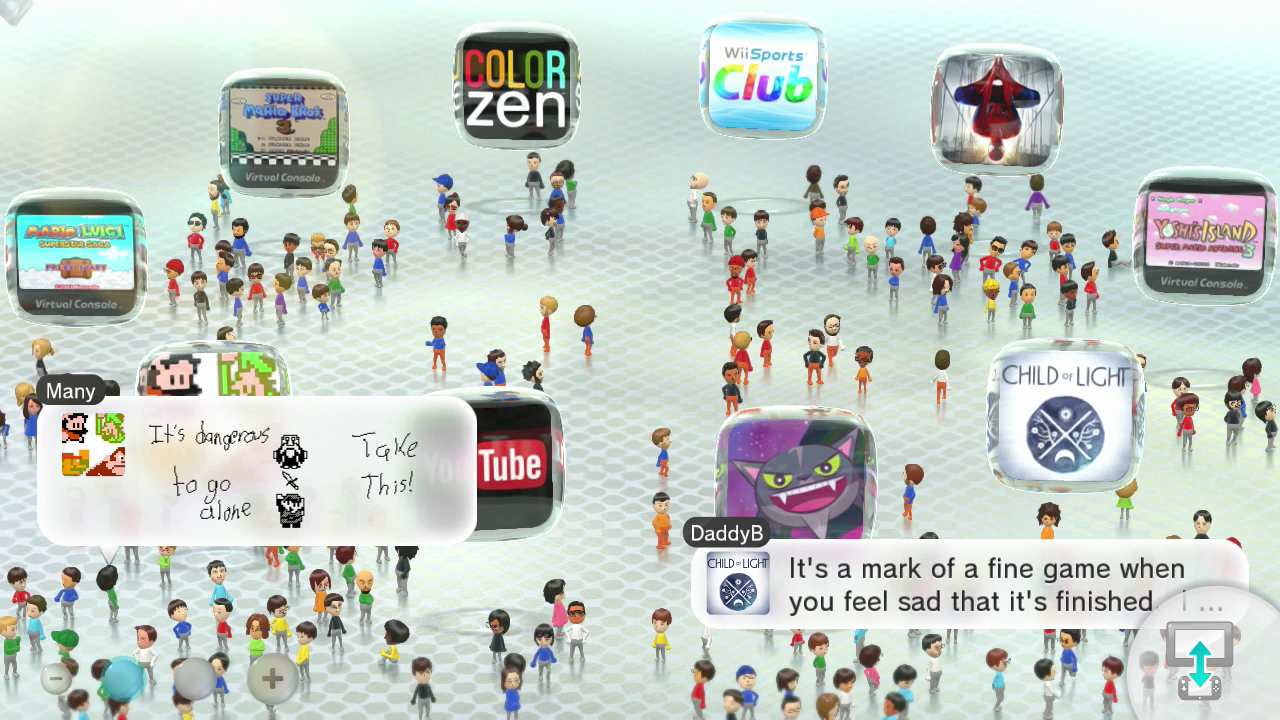
What Nintendo’s got that’s different and promising is the Miiverse. It’s not perfect, but what it has is personality. What it does is actually use the enthusiasm of online community to put more interesting wallpaper in the menus for its games and systems.
The Miiverse initially seemed like nothing more than a message board system that was largely designed to be used within Nintendo’s hardware. You’d log onto a Nintendo console or handheld and you’d find a MiiVerse community and chat about the game you were playing there. That kind of Nintendo-centric social network is interesting, but if that’s all it was going to be, it would likely inevitably lose to more widely-used social networks that aren’t Nintendo-specific. Plus, message board posts aren’t exactly all high-quality and plenty of MiiVerse posts are nothing special.
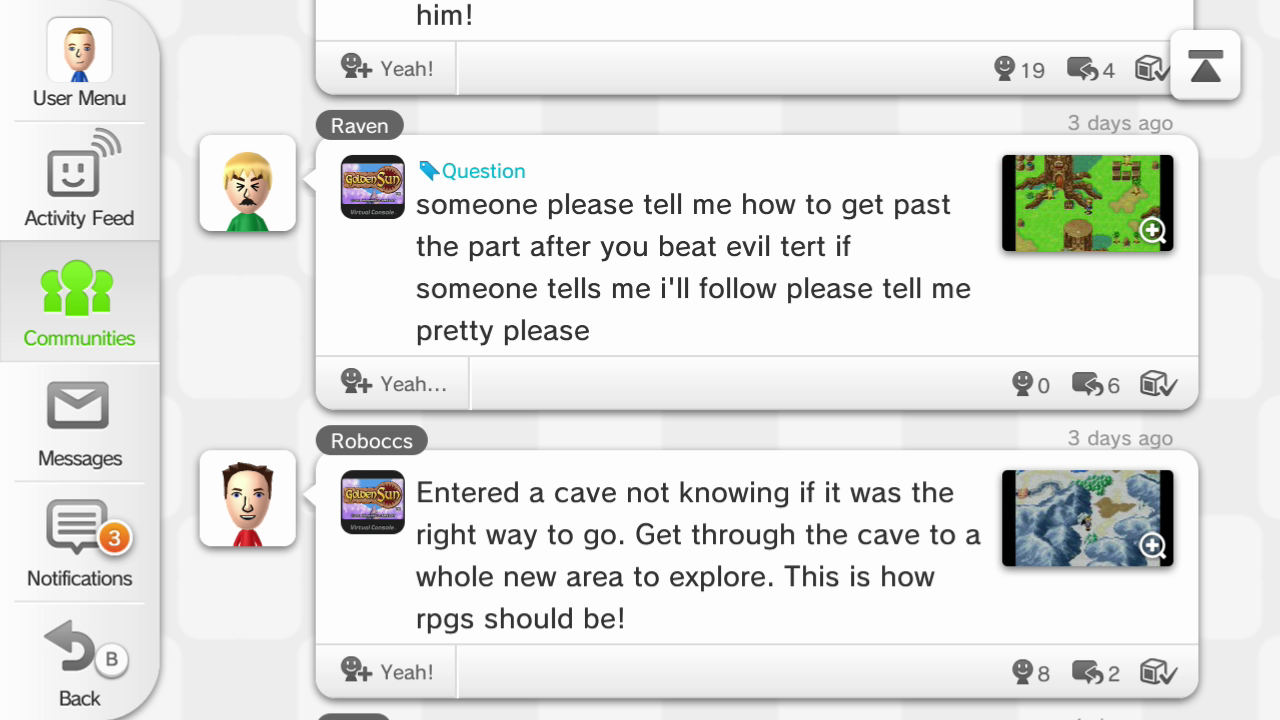
Miiverse, quite progressively, has also served as a good tool for getting hints from and offering advice to other gamers. On the Wii U, for example, it lets players screencap a tough part of a game, upload the screenshot to a Miiverse message board and ask for help, all without quitting the game. A player can even see if the person responding to them with advice has actually played the game in question.
The best thing about Miiverse, though, turns out to be that it was designed not just for a virtual keypad but for a stylus. Miiverse users have used the stylus to write messages to each other by hand but also to draw pictures.
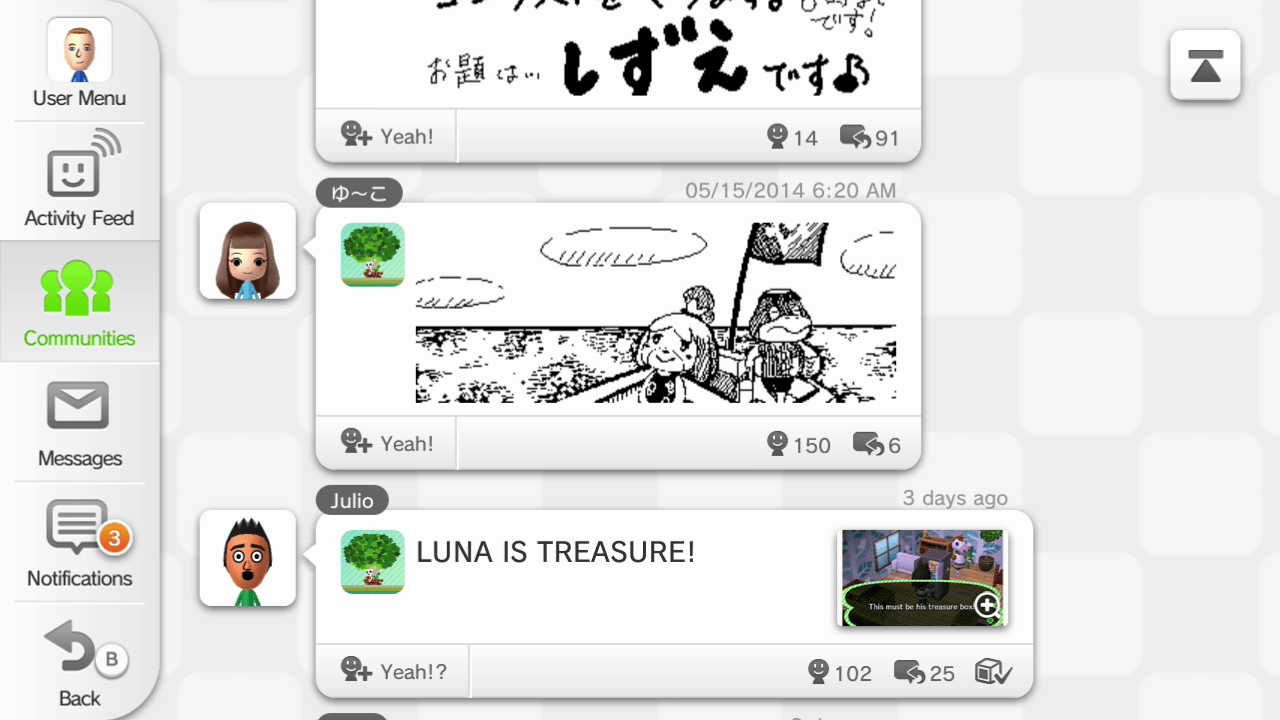
The result of that has been that game-specific message boards in the Miiverse wind up getting filled with fan art. Other gamers vote the best art to the top. Nintendo, seemingly to capitalise on this impulse, has started to include unlockable stickers in Wii U games such as Super Mario 3D World and NES Remix 2.
Because Wii U games often pull the best Miiverse messages back into the games that they’re about, you wind up with Nintendo menu screens like this for NES Remix 2, where one of the game’s players winds up contributing, even if just in a small way, to the look of the game:
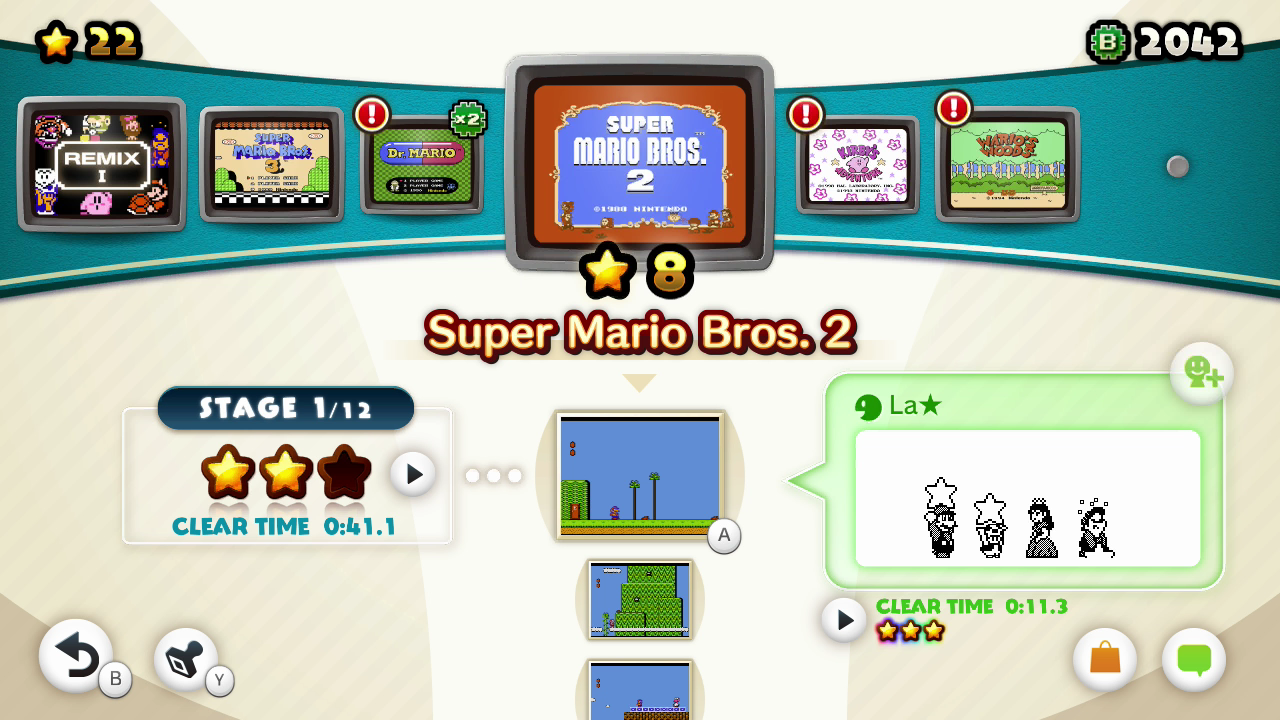
Where does something like this go? It’s hard to say.
What you can see, though, is that Nintendo’s Miiverse has allowed the creativity of its users to feed back into the experience that the mass of Nintendo system owners get while using the company’s hardware. A minority of creative users enhance the experience of a majority of players. Something similar happens on the PC with games that have modding tools or Steam Workshop supoort. You can also see this in games that allow lots of user-generated content — games such as LittleBigPlanet and Minecraft — but Nintendo’s service is doing it platform-wide, and, should 3DS Miiverse support improve, even effectively across multiple platforms.
How about that? Nintendo being progressive with an online service. Yes, this is happening.

There are other smart things Nintendo is doing. You can pick them out here and there: shaking up their Zelda formula, planning a unified iOS-like operating system across their future hardware and so on.
You can mix the smart things in with small and large head-scratchers: charging 3DS/Wii U consumers twice to play the newly re-released Super Mario Bros. 3 instead of making a purchase on one system unlock the game on the other; encouraging consumers to download their games while offering minuscule amounts of storage, by default, in their hardware; and so on.
You could make your lists. You could predict Nintendo’s future. You could dwell on Nintendo’s past. The fact is, though, that right now, in Nintendo’s present, the company is doing some key things well. It may not make Nintendo any more perfect than they ever were, but it does mean that there are still fun, fresh experiences to be had from the company and its systems.
Nintendo’s got problems, but they’re doing a bunch of things right, too. You can see that and enjoy the results — if you know what to look for.
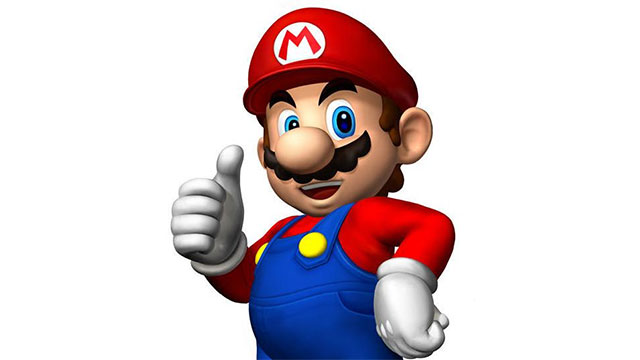
Comments
15 responses to “What Nintendo Is Doing Right”
I don’t know but the art on Miiverse is insane. My friend and I spend half an hour just looking through it all every time we play Wii U.
Pokemon MMO, where art thou.
Wish they’d release Rusty’s Real Deal Baseball over here in Aus. We like Baseball too, fuckers.
Pokemon MMO would be the killer app that could sell more than a few Wii U’s to a lot of people, it’s a shame that it probably won’t happen
Given how their online infrastructure crashed and burned horribly when they tried to roll out online Pokémon storage, they’ve still got a lot to learn before they can think about something like an MMO.
this article proudly brought to you by sponsorship
A super HD remake of the prime trillogy would be sick. And maybe scrub other M from the cannon?
i love the miiverse
the way its integrated is great.
i love the art, i love the sense of community on single player games and i miss it when its not there ie DKC.
it is something that i would like to see on the other consoles.
Lol. No amount of of propoganda will change peoples views.
The only way to ensure Nintendo get back to form is to send them a clear message that us old fans are tired of same games each generation. NOT to make excuses for them.
Just like no amount of propaganda makes their demise any more true. Now matter how badly Nintendo do they always have enough trump cards and best demographic in the industry.
Unlike Microsoft with Gears Of War, Halo or Sony with Uncharted and God of War.
Lets look further into the games industry and what other IP’s have a tonne of sequels.
Final Fantasy, Assassins Creed, Price Of Persia, Tales of series, Call of Duty, Tony Hawks, Street Fighter, Tekken, Castlevania, GTA and Tomb Raider, Should i go on?
It’s not just Nintendo that does this, the industry is full of rehashes and sequels, to point out just Nintendo for doing it while buying the next God of War or Halo is very short sighted and you would also be adding to the problem you pointed out.
It’s where the money is. For the mainstream gamer it’s what sells.
I’d take this article with a pinch of salt. New stuff is out there if you’re prepared to look. If you only focus on what mainstream developers are bringing to the table, then you’re always going to be disappointed.
Yeah i understand that, it’s just i am sick of people saying that Nintendo does nothing new and rehashes everything.
These are the same people that go out and buy COD every year or Assassins Creed, yet they never see the double standard they are holding Nintendo to.
I am fine with people disliking Nintendo, i just wish they would cut the bullshit excuses out.
Mario Kart looks good, but it still isn’t enough to make me want to buy a Wii U.
I’m ok with the storage options for the Wii U being small, since most external HDDs are supported.
Published =/= make/developed. I’d have thought a ‘Games Journalist’ would know that.
When I saw the headline I expected a much shorter article.
The only thing really wrong with them is that they seem to be limiting opportunities on their last devices as manipulation to buy their new ones.
They also create marvelous characters like Fawful and N, then expecting to throw them away easily. It’s heartbreaking to me that they would discard creative characters and then get stumped trying to create something more creative. If I could bring back some characters, I would work with them at minimum wage.